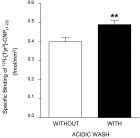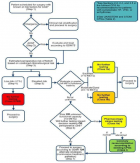Abstract
Editorial
Palliative care approach to oncological patient – Main points
Onur Öztürk*, Muhammed Emin Göktepe and Mustafa Ünal
Published: 31 March, 2020 | Volume 4 - Issue 1 | Pages: 015-016
According to the World Health Organization definition, palliative care is an approach aimed at increasing the quality of life of patients and their relatives by addressing physical, psychosocial and spiritual needs and treating conditions early, such as pain while they are coming to terms with a life-threatening disease [1]. Palliative care services have started a rapid progress in developed countries such as Scandinavian countries, England and Canada since the beginning of 1990 [2].
Although palliative care cares for any patient who is in need of care, whether bed-bound or unable to look after themselves, one of the main area of interest is of course oncological patients and their relatives. Patients with advanced cancer, frequent sufferings from physical and psychological symptoms - primarily pain, reduced functional capacity, and reduced quality of life are in the scope of palliative care protocol [3].
The most common end-of-life symptoms and signs in palliative cancer patients are pain, anorexia, nausea, cachexia, weakness, dyspnea, ascites, anxiety, agitation, delirium, confusion and pressure sores. In order to achieve quality and continuous care in case management, a family doctor, specific branch specialist, nurse, dietician, psychologist, cleric, etc. should work together in a multidisciplinary approach and clinical guidelines and care protocols should be implemented [4]. However, it should be kept in mind that increasing the medication dose may not always be beneficial to the oncological patients in palliative services. The goal should always be maximum benefit with minimal tests and treatment.
Palliative care does not aim to accelerate or postpone death; but it has many benefits in cancer patients and their relatives including the integration of the psychosocial and spiritual aspects of patient care into physical care, providing support for patients to live as active as possible until the last moment, improving the quality of life and the disease process, providing help and support in the grieving process [1,5].
Providing good care to advanced cancer patients requires that caregivers are educated and supported about their patients’ physical, psychological and social care needs. Balancing the physical and emotional needs of the caregivers will reduce the stress they experience, as well as increase the quality of life of their patients [6,7]. Professionalism in palliative care comes into play right at this point.
There is no consensus in the medical world about by whom, when and to whom palliative care should be given. In this regard, the conflicts of opinion between specific branches such as anesthesia, internal medicine and neurology are inevitable. We think that the team leader should be a family physician or a palliative care specialist. The reason for this is the family medicine’s principles of core competencies including biopsycosocial, holistic, comprehensive approach and equal distance to specific branches. Of course when the palliative care specialist is the team leader the patient’s own family doctor still provides invaluable service because of his intimate and long-term knowledge about the patients.
One key difference in some countries is that no distinction is being made between palliative and hospice care. Neither the insurance companies nor the state demands such classification because it doesn’t serve any practical purpose at the moment. However, in due time such distinction will be inevitable as one of the cost-cutting measure. Medical oncology will have to report about the expected survival of the cancer patients and it will further increase their workload given the exponential increase in cancer cases.
Read Full Article HTML DOI: 10.29328/journal.acst.1001015 Cite this Article Read Full Article PDF
References
- World Health Organization (WHO). Definition of palliative care. 2020.
- Klaschik E. Palliativmedizin. Praktische Einführung in Schmerztherapie, Symptomkontrolle, Ethik und Kommunikation ‘de. Eds. Husebø, Stein and Klaschik E. Berlin. 2000; 1-33.
- National Comprehensive Cancer Network NCCN Clinical Practice Guidelines in Oncology. 2009
- Aydoğan F, Uygun K. Kanser hastalarında palyatif tedaviler. Klinik Gelişim. 2011; 4-9.
- Hacialioglu N, Ozer N, Yilmaz Karabulutlu E, Erdem N, Erci B. The quality of life of family caregivers of cancer patients in the east of Turkey. Eur J Oncol Nurs. 2010; 14: 211-217. PubMed: https://www.ncbi.nlm.nih.gov/pubmed/20149734
- Kabalak AA, Öztürk H, Çağıl H. Yaşam sonu bakım organizasyonu; palyatif bakım. Yoğun Bakım Dergisi. 2013; 11: 56-70.
- Kim Y, Given BA. Quality of life of family caregivers of cancer survivors: across the trajectory of the illness. Cancer. 2008; 112: 2556-2568. PubMed: https://pubmed.ncbi.nlm.nih.gov/18428199/
Similar Articles
-
Theranostics: A Unique Concept to Nuclear MedicineLucio Mango*. Theranostics: A Unique Concept to Nuclear Medicine. . 2017 doi: 10.29328/journal.acst.1001001; 1: 001-004
-
Predictors of Candidemia infections and its associated risk of mortality among adult and pediatric cancer patients: A retrospective study in Lahore, Punjab, PakistanHafiz Muhammad Bilal*,Neelam Iqbal,Shazia Ayaz. Predictors of Candidemia infections and its associated risk of mortality among adult and pediatric cancer patients: A retrospective study in Lahore, Punjab, Pakistan. . 2018 doi: 10.29328/journal.acst.1001003; 2: 001-007
-
Endogenus toxicology: Modern physio-pathological aspects and relationship with new therapeutic strategies. An integrative discipline incorporating concepts from different research discipline like Biochemistry, Pharmacology and ToxicologyLuisetto M*,Naseer Almukhtar,Behzad Nili Ahmadabadi,Gamal Abdul Hamid,Ghulam Rasool Mashori,Kausar Rehman Khan,Farhan Ahmad Khan,Luca Cabianca. Endogenus toxicology: Modern physio-pathological aspects and relationship with new therapeutic strategies. An integrative discipline incorporating concepts from different research discipline like Biochemistry, Pharmacology and Toxicology . . 2019 doi: 10.29328/journal.acst.1001004; 3: 001-024
-
Insilico investigation of TNFSF10 signaling cascade in ovarian serous cystadenocarcinomaAsima Tayyeb*,Zafar Abbas Shah. Insilico investigation of TNFSF10 signaling cascade in ovarian serous cystadenocarcinoma. . 2019 doi: 10.29328/journal.acst.1001005; 3: 025-034
-
Fifth “dark” force completely change our understanding of the universeRobert Skopec*. Fifth “dark” force completely change our understanding of the universe. . 2019 doi: 10.29328/journal.acst.1001006; 3: 035-041
-
Risk factors of survival in breast cancerAkram Yazdani*. Risk factors of survival in breast cancer. . 2019 doi: 10.29328/journal.acst.1001007; 3: 042-044
-
Results of chemotherapy in the treatment of chronic lymphoid leukemia in Black Africa: Experience of Côte d’IvoirePacko Dieu-le-veut Saint-Cyr Sylvestre*,N’dhatz Comoe Emeraude,Kamara Ismael,Boidy Kouakou,Koffi Kouassi Gustave,Nanho Danho Clotaire,Koffi Kouassi Gustave. Results of chemotherapy in the treatment of chronic lymphoid leukemia in Black Africa: Experience of Côte d’Ivoire. . 2019 doi: 10.29328/journal.acst.1001008; 3: 045-048
-
Stercoral perforation: A rare case and reviewLava Krishna Kannappa*,Muhammad Sufian Khalid,May Hnin Lwin Ko,Mohsin Hussein,Jia Hui Choong,Ameer Omar Rawal-Pangarkar,Danaradja Armugam,Yahya Salama. Stercoral perforation: A rare case and review. . 2019 doi: 10.29328/journal.acst.1001009; 3: 049-051
-
Different optimization strategies for the optimal control of tumor growthAbd El Moniem NK*,Sweilam NH,Tharwat AA. Different optimization strategies for the optimal control of tumor growth. . 2019 doi: 10.29328/journal.acst.1001010; 3: 052-062
-
Risk factor of liver metastases in breast cancerAkram Yazdani*. Risk factor of liver metastases in breast cancer. . 2019 doi: 10.29328/journal.acst.1001011; 3: 063-065
Recently Viewed
-
A Comparative Analysis of Traditional Latent Fingerprint Visualization Methods and Innovative Silica Gel G Powder ApproachBhoomi Aggarwal*. A Comparative Analysis of Traditional Latent Fingerprint Visualization Methods and Innovative Silica Gel G Powder Approach. J Forensic Sci Res. 2024: doi: 10.29328/journal.jfsr.1001063; 8: 040-046
-
A Comparative Study of Metoprolol and Amlodipine on Mortality, Disability and Complication in Acute StrokeJayantee Kalita*,Dhiraj Kumar,Nagendra B Gutti,Sandeep K Gupta,Anadi Mishra,Vivek Singh. A Comparative Study of Metoprolol and Amlodipine on Mortality, Disability and Complication in Acute Stroke. J Neurosci Neurol Disord. 2025: doi: 10.29328/journal.jnnd.1001108; 9: 039-045
-
Huge Mucinous Cyst Adenoma, Case Report SeriesAli Mohammed Ali Elimam*,Isam Mohamed Babbiker,Reem Mohammed Elhaj Farah,Ayat Salih Abbas,Omer Mohamed Abubeker Sayed. Huge Mucinous Cyst Adenoma, Case Report Series. Clin J Obstet Gynecol. 2025: doi: 10.29328/journal.cjog.1001184; 8: 019-022
-
Does change in cervical dilation after anesthesia impact latency after cerclage placement?Michelle N Lende*, Paul J Feustel, Erica K Nicasio, Tara A Lynch. Does change in cervical dilation after anesthesia impact latency after cerclage placement?. Clin J Obstet Gynecol. 2023: doi: 10.29328/journal.cjog.1001125; 6: 028-031
-
Minimally invasive cytoreductive surgery in advanced ovarian cancer: A nonselected consecutive series of robotic-assisted casesNatalie Shammas*, Rosa Avila, Christopher Khatchadourian, Erland Laurence Spencer-Smith, Lisa Stern, Steven Vasilev. Minimally invasive cytoreductive surgery in advanced ovarian cancer: A nonselected consecutive series of robotic-assisted cases. Clin J Obstet Gynecol. 2023: doi: 10.29328/journal.cjog.1001126; 6: 032-037
Most Viewed
-
Evaluation of Biostimulants Based on Recovered Protein Hydrolysates from Animal By-products as Plant Growth EnhancersH Pérez-Aguilar*, M Lacruz-Asaro, F Arán-Ais. Evaluation of Biostimulants Based on Recovered Protein Hydrolysates from Animal By-products as Plant Growth Enhancers. J Plant Sci Phytopathol. 2023 doi: 10.29328/journal.jpsp.1001104; 7: 042-047
-
Sinonasal Myxoma Extending into the Orbit in a 4-Year Old: A Case PresentationJulian A Purrinos*, Ramzi Younis. Sinonasal Myxoma Extending into the Orbit in a 4-Year Old: A Case Presentation. Arch Case Rep. 2024 doi: 10.29328/journal.acr.1001099; 8: 075-077
-
Feasibility study of magnetic sensing for detecting single-neuron action potentialsDenis Tonini,Kai Wu,Renata Saha,Jian-Ping Wang*. Feasibility study of magnetic sensing for detecting single-neuron action potentials. Ann Biomed Sci Eng. 2022 doi: 10.29328/journal.abse.1001018; 6: 019-029
-
Pediatric Dysgerminoma: Unveiling a Rare Ovarian TumorFaten Limaiem*, Khalil Saffar, Ahmed Halouani. Pediatric Dysgerminoma: Unveiling a Rare Ovarian Tumor. Arch Case Rep. 2024 doi: 10.29328/journal.acr.1001087; 8: 010-013
-
Physical activity can change the physiological and psychological circumstances during COVID-19 pandemic: A narrative reviewKhashayar Maroufi*. Physical activity can change the physiological and psychological circumstances during COVID-19 pandemic: A narrative review. J Sports Med Ther. 2021 doi: 10.29328/journal.jsmt.1001051; 6: 001-007

HSPI: We're glad you're here. Please click "create a new Query" if you are a new visitor to our website and need further information from us.
If you are already a member of our network and need to keep track of any developments regarding a question you have already submitted, click "take me to my Query."


















































































































































